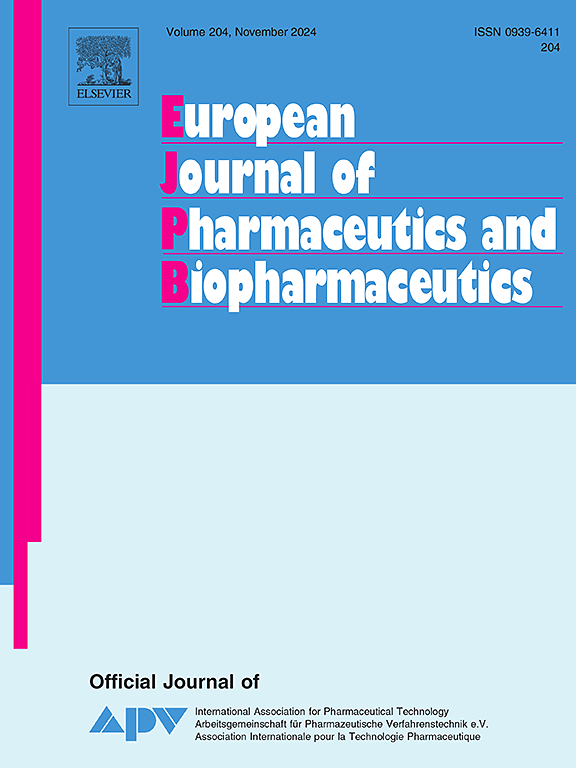多级微流控辅助双药快速顺序封装的协同递送平台。
IF 4.4
2区 医学
Q1 PHARMACOLOGY & PHARMACY
European Journal of Pharmaceutics and Biopharmaceutics
Pub Date : 2025-02-01
DOI:10.1016/j.ejpb.2024.114616
引用次数: 0
摘要
在单一纳米药物载体中整合多种治疗药物有望推进抗肿瘤治疗,尽管它们的不同物理化学性质带来了挑战。本研究介绍了一种新型多级微流体共封装平台,旨在解决这些挑战。通过精心编排纳米沉淀过程顺序,该平台实现了两种物理化学特性明显不同的药物的顺序包封。采用多级微流控TrH芯片,合成了紫杉醇(PTX)-辛伐他汀(SV)、PTX-lenvatinib (LV)和SV-LV的混合纳米颗粒(HNPs)。与传统的Bulk方法和现有的商业微流控Tesla和Baffle芯片不同,这里生产的HNPs具有核壳结构和均匀的粒径分布,这对提高药物递送效率至关重要。值得注意的是,该方法在双药进料比为1:4至4:1的情况下,两种药物的包封效率接近100% %。药物装载效率量化PTX-SV /卫生系统(14.97 ±1.19 %),PTX-LV /卫生系统(16.58 ±0.69 %),和SV-LV /卫生系统(19.21 ±2.38 %)。体外释药实验证实,PTX-SV/HNPs具有SV和PTX的顺序释放特性。值得注意的是,与单独的PTX和SV治疗相比,PTX-SV/HNPs对HepG2细胞表现出更强的细胞毒性,强调了它们在癌症治疗中的潜力。综上所述,所开发的多级微流控平台代表了一种强大的策略,可以共同封装具有重大物理化学差异的药物,从而为推进纳米医学应用中的多药递送提供了一条有希望的途径。本文章由计算机程序翻译,如有差异,请以英文原文为准。

Multistage microfluidic assisted Co-Delivery platform for dual-agent facile sequential encapsulation
The integration of multiple therapeutic agents within a single nano-drug carrier holds promise for advancing anti-tumor therapies, despite challenges posed by their diverse physicochemical properties. This study introduces a novel multi-stage microfluidic co-encapsulation platform designed to address these challenges. By carefully orchestrating the nano-precipitation process sequence, this platform achieves sequential encapsulation of two drugs with markedly different physicochemical characteristics. Using the multi-stage microfluidic TrH chip, hybrid nanoparticles (HNPs) loaded with paclitaxel (PTX)-simvastatin (SV), PTX-lenvatinib (LV), and SV-LV were synthesized. Unlike conventional Bulk methods and existing commercial microfluidic Tesla and Baffle chips, the HNPs produced here exhibit a core–shell structure and uniform particle size distribution, crucial for enhancing drug delivery efficacy. Notably, this method achieves nearly 100 % encapsulation efficiency for both drugs across a dual-drug feed ratio range from 1:4 to 4:1. Drug loading efficiencies were quantified for PTX-SV/HNPs (14.97 ± 1.19 %), PTX-LV/HNPs (16.58 ± 0.69 %), and SV-LV/HNPs (19.21 ± 2.38 %). PTX-SV/HNPs demonstrated sequential release characteristics of SV and PTX, as confirmed by in vitro drug release experiments. Significantly, PTX-SV/HNPs exhibited superior cytotoxicity against HepG2 cells compared to individual PTX and SV treatments, underscoring their potential in cancer therapy. In conclusion, the developed multi-stage microfluidic platform represents a robust strategy for co-encapsulating drugs with substantial physicochemical disparities, thereby offering a promising avenue for advancing multi-drug delivery in nanomedicine applications.
求助全文
通过发布文献求助,成功后即可免费获取论文全文。
去求助
来源期刊
CiteScore
8.80
自引率
4.10%
发文量
211
审稿时长
36 days
期刊介绍:
The European Journal of Pharmaceutics and Biopharmaceutics provides a medium for the publication of novel, innovative and hypothesis-driven research from the areas of Pharmaceutics and Biopharmaceutics.
Topics covered include for example:
Design and development of drug delivery systems for pharmaceuticals and biopharmaceuticals (small molecules, proteins, nucleic acids)
Aspects of manufacturing process design
Biomedical aspects of drug product design
Strategies and formulations for controlled drug transport across biological barriers
Physicochemical aspects of drug product development
Novel excipients for drug product design
Drug delivery and controlled release systems for systemic and local applications
Nanomaterials for therapeutic and diagnostic purposes
Advanced therapy medicinal products
Medical devices supporting a distinct pharmacological effect.

 求助内容:
求助内容: 应助结果提醒方式:
应助结果提醒方式:


